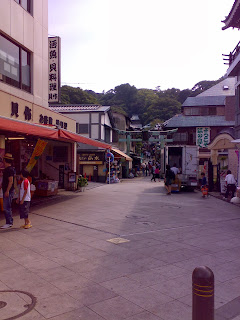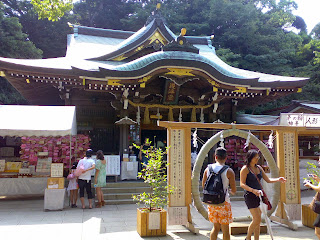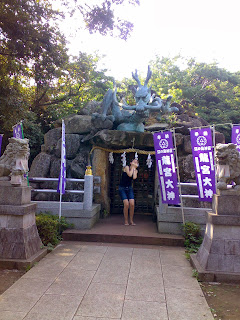Prima di raggiungere la stazione di Enoshima, si percorre un tratto di costa dalle spiagge piatte e larghe, ma non bianche, noto col nome di Shonan, tratto famoso per surf e windsurf. Da qui è possibile vedere l'isola di Enoshima e sullo sfondo, l'imponente monte Fuji. Quest'isola ricorda tanto una famosa isola in Sicilia, l'isolabella di Taormina, infatti si trova poco lontano dalla terraferma, collegata ad essa da un ponte di sabbia che scompare con l'alta marea. Però, poichè qui siamo in Giappone, non poteva certo mancare l'opera architettonica, e quindi l'isolotto è collegato alla terra da un bel ponte asfaltato di 600 metri. In effetti l'isola è abbastanza grande, abitata, vivace e turistica. Tutte le stradine sono pavimentate, le case sono in stile rustico, ci sono hotels e ristoranti, e c'è un porto dove è possibile ammirare moltissime barche a vela e altre imbarcazioni. Altra cosa che ricorda la Sicilia è proprio l'urbanistica del paesino, che sembra Castelmola, il piccolo centro abitato che torreggia su Taormina.
A guardare dall'alto la spiaggia e l'isola ci stanno bellissimi esemplari di aquila, che dimorano sui fianchi delle rocce dell'isola. Non solo ad Enoshima, ma in tutta l'area marina, vi sono cartelli che mettono in guardia la gente di non alzare al cielo nessun tipo di pietanza (ad esempio gli spiedini) perchè le aquile non aspettano altro e potrebbero buttarsi in picchiata per rubarvi il lauto spuntino. E le aquile sono davvero grandi e a volte calano minacciosamente in basso, quasi ad altezza d'uomo.
L'isola non è solo ovviamente ristoranti e casettine che sembrano disegnate all'acquerello. Enoshima è anche piena di templi e simboli. Fondamentalmente, la fama dell'isola è di essere un posto per gli innamorati. Infatti il tempio più grande ospita le targhette in legno tipiche delle preghiere buddiste, ma sono colorate di rosa e hanno come sfondo un cuore. E' su queste tavolette che gli innamorati scrivono le loro preghiere e i loro desideri. Sull'isola c'è anche un faro, da cui è possibile godere di una meravigliosa vista sulla costa e l'entroterra, c'è una sala per la meditazione, guardata notte e giorno da due minacciosi guardiani in pietra dipinta, ove è possibile acquistare fogliettini in cui vi sono scritte delle profezie, è possibile bruciare stecche di incenso ed è possibile pregare e provare l'esperienza della meditazione zen, osservando il più assoluto e rispettoso silenzio.
Tornando a parlare di aquile, ma in un diverso contesto, sull'isola esiste un altro simbolo per gli innamorati che è chiamato "campana del drago". Qui gli innamorati vengono a incatenare un lucchetto con le loro iniziali incise o con una data o una scrttura, simbolo del loro amore, vicino alla campana, suonano poi la campana stessa che risuona per tutto l circondario. E proprio qui ho avuto tanta paura visto che le aquile, forse attirate dai rintocchi di campana, forse attirate dal viavai di gente, o non so, venivano giù vicinissime. Fortuna che c'erano tanti alberi sotto cui trovare riparo. Qualcuno avrà già trovato la similitudine con un altro simbolo d'amore lanciato da un film di qualche tempo fa avente come soggetto i lucchetti...chissà che magari Muccino si sia ispirato a questa campana...
Poi ancora, panorami stupendi, vedute di pescatori sugli scogli con il mare agitato, anfratti rocciosi, vele bianche spiegate al vento in lontananza, tavole da surf serpeggianti sull'acqua.
Accompagnata nelle mie escursioni da Mladen, si aggiunge a noi un tizio americano-cinese-tailandese in trasferta in Giappone che prima ci ferma e ci chiede "sapete dov'è l'acquario?" e poi, sentendo tra una chiacchiera e l'altra che stiamo andando alla scoperta dei segreti dell'isola, decide di lasciar perdere la gita all'acquario e si unisce alla spedizione. Un pò noioso e scontato, ma dopo tutto non pericoloso, seppure si sia auto invitato.
La spiaggia in se, sulla terraferma, invece non ha molto di che vantarsi (soprattutto se paragonata a certi scenari del mio Mediterraneo): una lunga distesa di terriccio fine e scuro, che si appiccica all'istante. Non certo come la bianchissima spiaggia di Shirahama giù a Izu, eppure non male godersi qualche ora di relax a crogiolarsi al sole. Sole che tra le altre cose è stato, finalmente, presente per tutta la giornata. parlando poi dei comportamenti dei giapponesi in spiaggia ci sarebbe tanto da dire, magari di questo e altro se ne parlerà in una nuova puntata della serie Lifestyle.
***********************************
This late-august weekend is marked with a day with sun and sea. The place I chose to go to is not far from Tokyo, only 50min by train, and it's interesting geography-wise, history-wise, tradition-wise, but it's more interesting to me because it reminds of home. I went to Enoshima.
Before getting to Enoshima station we passed by a stretch of coast with flat and large beaches named Shonan and famous for surf and windsurf. From here you can see Enoshima island and Mount Fuji on the background. this island reminds of a famous island in Sicily, "Isolabella" in Taormina, as this one too is not too far from the mainland, connected to it through a narrow sandy bridge that disappears with the high water. But here we're in Japan, so we can't miss the architectural works and indeed there's a concrete 600meters long bridge. In facts, the island is quite big, people living there, it's lively and touristic. all the streets are paved, the houses are very typical, rough but cute, there are hotels and restaurants, there's a port where it's possible admiring many sailing boats and other ships. Another thing that reminds of Sicily is the urban setting of the town, resembling "Castelmola", one small town built on the rocky rocks above Taormina.
Watching the island and the beach from the sky are beautiful eagles, that live on the sides of the rocks in the island. Not only in Enoshima, but around a huge marine area, are cartoons that suggests to watch out the eagles because in case people wave or rise hands with some food, the eagles come down to pick it. And the eagles are very big and sometimes they fly very low.
The island is not only restaurants and cute painting-like houses. Enoshima is full of temples and symbols. Basically, the island is known to be a place for lovers. The main temple, indeed, hosts the typical wooden plates for the wishes, but they are pink and a heart is drawn on them. On those plates the lovers write down their wishes and prayers. On the island there's also a lighthouse from which you can enjoy a nice view on the mainland, then there's a meditation hall, watched by two scary guardians, where you can buy prophecies, burn incense sticks and experience the zen meditation in the total absolute respectful silence.
Talking about eagles again, but in another context, on the island there's another symbol of love, called "dragon bell". Here lovers come and put locks with their initials or dates or whatever, as a symbol of their love, and then they gong the bell together. Here is where I was really scared by the eagles that, perhaps attracted by the sound of the bell, or by the crowd of people, came very very close to us. In Italy we had a novel writer who wrote a story with a similar subject, a movie was made out the novel and now, in the reality, we have in Rome a light pole where lovers, following the protagonists of the novel, lock their locks as a promise of eternal love. ...who knows, maybe Muccino, the writer, was inspired by the dragon bell....
Also, beautiful panoramas, wonderful views of fishermen on the cliffs with the big sea, rocky holes, white sails open in the wind, surf boards riding the shallow waves.
The beach on the mainland has nothing to be proud of (especially if compared to some sceneries of the Mediterranean sea): a long stretch of dark fine soil, instantly sticking. Not like the beautiful beach of Shirahama down in Izu, and yet enjoying a few hours of relax under the sun wasn't that bad. A lot can be said about the Japanese fashions on the beach, but this is material for another chapter of my Lifestyle series.
















